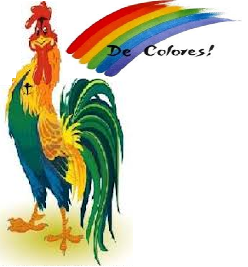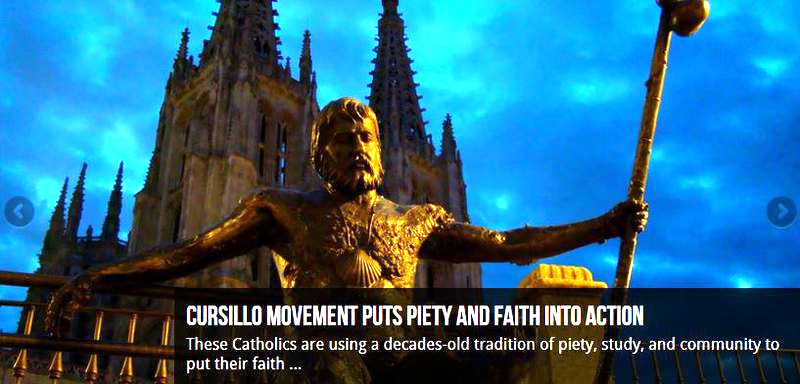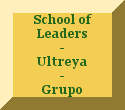Make a Friend
Be a Friend
Bring a Friend
Fifty Years of Cursillo in Gallup, NM
1961-2011

What is Cursillo?
The Spanish word Cursillo (ker-SEE-yo) means "short course" and is often associated with a 3-Day Weekend. The proper name is Cursillo de Cristiandad (short course in Christianity). However, there is much more to the Cursillo Movement than just a 3-Day Weekend. VIDEO -
Purpose of the Cursillo Movement
The purpose of the Cursillo Movement is to bring about a change in the environments. The Cursillo Movement is a deliberate act to bring Jesus Christ into the world. Cursillistas (those that have gone through the 3-Days and are living the Cursillo method) become agents for change in their families, work situations, neighborhoods, social gatherings, etc. Cursillistas are the part of the Christian community (communal) that links together with others (teamwork) to bring Jesus Christ to the world.
History of the Cursillo Movement
The Cursillo Movement is a movement of the Catholic Church that evolved from Spain, where it got its origin in the 1940s. God taught a group of men how to work for Him in an effective way, a way that bears fruit. In the late 1940s, the first Cursillo was given and the Cursillo Movement began. Those who make Cursillo's today would find much of the first Cursillo familiar. The Cursillo has been refined and changed somewhat, but today's Cursillo weekend remains basically the same as those first Cursillo's.
The first Cursillo in the United States was held in Waco, Texas, in 1957. The key figures in the beginning were Father Gabriel Fernandez and two airmen from Spain, Bernardo Vadell and Agustin Palomino, who were training with the United States Air Force. Father Gabriel had arrived in Waco in 1955 from Spain where he had made his three days under two of the founders of the movement, Father Juan Capo and Eduardo Bonnin. The priest and the airmen were responsible for putting on the first two weekends in Waco.In 1959, the Cursillo spread throughout Texas and to Phoenix, Arizona. In August of that year the first national convention of spiritual directors was held, and Ultreya magazine began publication. In 1960, the growth of the Cursillo quickened in the Southwest, and weekends were held for the first time in the East in New York City and Lorain, Ohio. Until 1961, all weekends were held in Spanish. That year the first English-speaking weekend was held in San Angelo, Texas. Also in 1961, first weekends were held in San Francisco, California; Gary, Indiana; Lansing, Michigan; and Gallup, New Mexico. By 1962, twenty-five more English-speaking weekends had been held.
In 1962, the Cursillo Movement came to the Eastern United States. Weekends were held in Cincinnati, Brooklyn, Saginaw, Miami, Chicago, Detroit, Newark, Baltimore, Grand Rapids, Kansas City and Boston. In the West, the first weekends were held in Monterey, Sacramento, Los Angeles, Pueblo and Yakima. The movement spread rapidly with the early centers carrying the Cursillo to nearby dioceses. As of 1981, almost all of the 160 dioceses in the United States had introduced the Cursillo Movement.
The Cursillo Movement in the United States was organized on a national basis in 1965. At this meeting a National Secretariat was organized, and a National Cursillo Office (currently in Dallas, Texas) was established. The Cursillo Movement has the support of the vast majority of the American hierarchy. It is joined to the National Conference of Catholic Bishops through an official liaison in the person of Most Rev. James S. Sullivan, Bishop of Fargo, and through the Bishops' Secretariat for the Laity in Washington, D.C.
Today, it is a worldwide movement with centers in nearly all South and Central American countries, the United States, Canada, Mexico, Portugal, Puerto Rico, Great Britain, Ireland, France, Germany, Austria, Italy, Yugoslavia, Australia, Japan, Korea, Taiwan, the Philippines, Sri Lanka and in several African countries. The movement is a member of the International Catholic Organizations of the Pontifical Council for the Laity in Rome. In 1980, the Cursillo Movement established an international office, the OMCC (Organismo Mundial de Cursillo's de Cristiandad), in Santo Domingo to coordinate the three existing international working groups of Latin America, Europe and the International English Language Group. The international leaders of the movement meet periodically to further its work.




